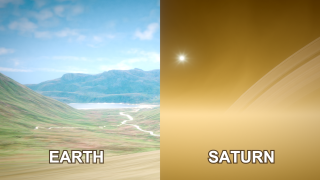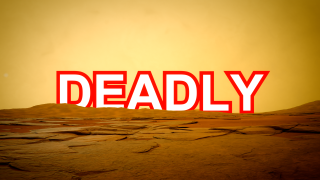What YOU Would See From Each PLANET
Published: April 12, 2025 at 9:45 PM (PT)
8:51
(15955 frames/30fps) Resolution:3840x2160
(4K/UHD) Most Rewatched:6:32 to 6:48 Realtime Statistics...
30 Minutes...
Hour...
24 Hours...
Information Sources
https://nssdc.gsfc.nasa.gov/planetary/factsheet/sunfact.html
Watt Definitionhttps://en.wikipedia.org/wiki/Watt
8 Planets Factsheethttps://blendertimer.com/factsheets/solar-system/planet-factsheet
Sun Visible Brightness Formula (W/m²)(3.828*(10^26))/((4*π)*(d^2))*0.43 - (d=distance to Sun in meters)
NASA - Mercury Factshttps://science.nasa.gov/mercury/facts
Stellariumhttps://stellarium.org
NASA - Venus Factshttps://science.nasa.gov/venus/venus-facts
Venus Missionshttps://science.nasa.gov/venus/exploration
Longest Time Survived on Venus by a Spacecrafthttps://www.guinnessworldrecords.com/world-records/78367-longest-time-survived-on-venus-by-a-spacecraft
Lead Factshttps://en.wikipedia.org/wiki/Lead
Venus Casts Shadowshttps://skyandtelescope.org/astronomy-news/venus-shadow-casting
NASA - Earth Factshttps://science.nasa.gov/earth/facts
NASA - Mars Factshttps://science.nasa.gov/mars/facts
Phobos Factshttps://en.wikipedia.org/wiki/Phobos_(moon)
Asteroid Belt Factshttps://en.wikipedia.org/wiki/Asteroid_belt
5 Dwarf Planets Factsheethttps://blendertimer.com/factsheets/solar-system/dwarf-planet-factsheet
NASA - Jupiter Factshttps://science.nasa.gov/jupiter/facts/
Astronomical and Light Datahttps://www.iau.org/static/resolutions/IAU1976_French.pdf#page=9
NASA - Saturn Factshttps://science.nasa.gov/saturn/facts
Rings of Saturnhttps://en.wikipedia.org/wiki/Rings_of_Saturn
NASA - Uranus Factshttps://science.nasa.gov/uranus/facts
NASA - Neptune Factshttps://science.nasa.gov/neptune/neptune-facts
Brightness of Day and Nighthttps://en.wikipedia.org/wiki/Daylight
Graphic Sources
Audio Sources
N/A
Dwindling Hope (Daniel Roberts)https://pixabay.com/music/ambient-dwindling-hope-287000
Journey Through Nothing-Ambient Background Loop (Daniel Roberts)https://pixabay.com/music/adventure-journey-through-nothing-ambient-background-loop-232364
Camera Exposure Dial (Daniel Roberts)N/A
Venera 14 Venus Audio (Soviet Academy of Sciences)https://archive.org/details/venera-14-venus-recording
softwind-birds.wav (ellanjellan)https://freesound.org/people/ellanjellan/sounds/525256
0017_explo_bomb_01_PremiumBeat (Detonate, PremiumBeat)https://www.premiumbeat.com/blog/free-explosion-sfx-vfx-elements
First Audio Recording of Sounds on Mars (NASA/JPL)https://science.nasa.gov/resource/first-audio-recording-of-sounds-on-mars
Wind (Daniel Roberts)https://pixabay.com/sound-effects/wind-13850
Chapters
Introduction
0:16Mercury
1:29Venus
3:04Earth
3:43Mars
4:32Ceres
5:07Jupiter
5:53Saturn
6:36Uranus
6:58Neptune
7:42Pluto
7:53Haumea
8:13Makemake
8:23Eris
8:42Outro
Ahh...isn't a perfectly clear
sky just so beautiful? Why does
the Sun look so small though?
Wait...wait...what?!
*clears throat*
So basically we're gonna see
what it would look like on other planets.
Starting with the closest to the
Sun, Mercury.
So here we are on Mercury. That's
a bit bright, let me turn down
my exposure. The Sun obviously
appears much larger here than
it does on Earth, and thus much
brighter. Mercury has no atmosphere,
no moons, and some very extreme
temperatures. Daytime temperatures
can reach highs of 430 degrees
Celsius with nighttime temperatures
dipping down as low as -180 degrees
Celsius, the average temperature
being 167 degrees Celsius. Why
do I sound like the weather radio...
Anyway, Mercury makes one full
rotation in about 58 Earth days,
which is a pretty long day.
But, because Mercury orbits the
Sun so fast—about once every 88
Earth days—the actual day length
on Mercury is 175 Earth days,
, which...is a very long time
for a single day. Imagine working
2800 hour days, or since a year
on Mercury is shorter than its
day, imagine working 1.3 year days. What...
This odd effect also causes
the Sun to briefly appear to reverse
direction during the day.
If you know anything about the
Solar System you know which planet
is next, and that is Venus. Unlike
Mercury, Venus has an atmosphere
and a thick and deadly one at that.
The atmosphere is mostly carbon
dioxide with clouds composed of
sulfuric acid. This is literally
the image you get in your head
when you think of a deadly planet.
In fact it's so deadly that out
of the 10 landers which have successfully
landed on Venus, most lasted less
than an hour and the longest time
survived was just 2 hours and
7 minutes. When you have hurricane-force
winds, atmospheric pressures equal
to being 1 kilometer underwater,
and temperatures hot enough to
melt lead...eh let's just say
even electronics don't really
stand a chance.
But, Venus is special for more
reasons than just being incredibly hostile.
From Earth, Venus is the third
brightest object in the sky, with
only the Moon and Sun being brighter.
At night on Earth, if there's
no ambient light, such as the
Moon, Venus is actually bright
enough to cast shadows! And, I
was even able to photograph it
during the middle of the day once!
Speaking of brightness, this is
what it would look like here at
our normal Earth exposure.
Venus is also special because
it's the hottest planet in the
Solar System, is almost the same
size as Earth, and it spins backwards
making the Sun rise in the west
and set in the east. Not that
you can see it very well since
the atmosphere is so dense, but
anyway...
Onward to Earth! That sounds
strange...
Most of us know what this looks
like already so it's actually
a bit boring compared to what
we've just seen, not to mention
the fact that my 3D modelling
skills are kind of terrible so
this looks pretty bad. Average
temperatures are about what you'd expect.
There is one thing that's quite
a bit different about this planet
than all the others and that is,
of course, life! The vast amount
of life forms on Earth as well
as their vastly different and
often unique designs are what
really make this place stand out
from the rest and feel like home.
Unlike the other planets, Earth
isn't quite so hostile. *bomb explosion*
I take that back
and we're moving on.
Here we are on Mars. This planet
has been studied quite a lot.
The temperatures range from -153
degrees Celsius at night, to 35
degrees Celsius during the day,
with the average temperature
being around -63 degrees Celsius.
Mars is special because its
day length is just 40 minutes
longer than Earth's day length
of 24 hours. Oh, and Mars has
2 Moons, Phobos and Deimos. Phobos
orbits Mars faster than Mars itself
rotates, this makes it appear
that Phobos rises in the west
and sets in the east. I.e. it
appears to go backwards in the sky.
Also, quick Earth exposure as
a reference before we continue.
It is starting to get noticeably
darker as we get farther from
the Sun.
Quick side trip while we're
looking at stuff, this is the
Sun from Ceres. Not anything particularly
special except that it is getting
noticeably darker, but just for
anyone curious, this is about
what it'd look like. You'll notice
that you can't really see any
other asteroids, and that's simply
because despite there being millions
of asteroids, the asteroids are
spread out over such a large area
of space that the distances between
them are extremely large. This
is why we can send spacecraft
though the asteroid belt with
basically no worries of it colliding
with an asteroid. Anyway, on to Jupiter!
This is our first gas giant,
so there's technically no surface,
you're just levitating in the
air, or whatever you want to call
this stuff. We're now over 5 times
farther from the Sun than Earth,
so it is considerably darker,
which basically means I need
to boost my exposure so that we
can actually see stuff. You might've
noticed that it's incredibly windy
here, and that's a trend you'll
notice with all the gas and ice giants.
The temperature here averages
about -108 degrees Celsius. Jupiter
is very special being the largest
planet in the Solar System and
spinning the fastest with a day
lasting just under 10 hours.
Light from the Sun takes over
43 minutes to reach Jupiter! If
you didn't know that, I'd recommend
going and watching my 9 hour long vid...
Guess what, it's Saturn time!
With a fairly major exposure boost
this planet will give you perhaps
the most interesting view with
the rings looking so incredibly
beautiful and dreamlike. It's
almost hard to believe that this is real.
Eh...well I... I mean it's not...
well...well it is but it's like...
like...not...this...this video...
whatever. The average temperature
here is about -139 degrees Celsius.
And Saturn has the most moons
of any planet in the Solar System,
146 moons!
Ahh...gotta take at least a
minute to absorb this incredible
view though, am I right? Ha! Nope!
We've got more planets to go to!
I can literally barely see.
But, here's the Sun from Uranus.
The average temperature here
is about -197 degrees Celsius.
Uranus holds the record for the
coldest recorded temperature out
of all the 8 planets. Neptune
is still colder on average, though.
And here we are on Neptune.
The last of the 8 major planets
and one with some terribly fast winds.
These winds whip clouds of frozen
methane across the planet at speeds
of over 2,000 kilometers per hour!
The average temperature here
is about -201 degrees Celsius.
The average brightness here, in
the middle of the day, is very
low being about 9,000 times darker
than noon on Earth. Let me reset
my exposure to what we used on
Earth so you can see just how
dark it is here. At this distance,
the Sun is so tiny that it's
almost hard to believe we're orbiting it.
Before we end, let's take a
quick peek at the last 4 dwarf
planets, just for fun.
This is Pluto. It's very dark here.
This is Haumea. Also, very dark.
Who would've guessed... Oh and
I should probably specify that
we don't actually know a whole
lot about these last 3 dwarf planets
so, this is about what it looks
like but it might also not be.
Here's Makemake. Not too much
farther than Haumea and Pluto.
And lastly, Eris. Over 10 billion
kilometers from the Sun. It's
basically the middle of space
now, or at least it sure feels
like it.
But that's basically it! You
know, if this video wasn't boring
enough for you, you should go
and watch my 9 hour long vid...


 April 12, 2025
April 12, 2025